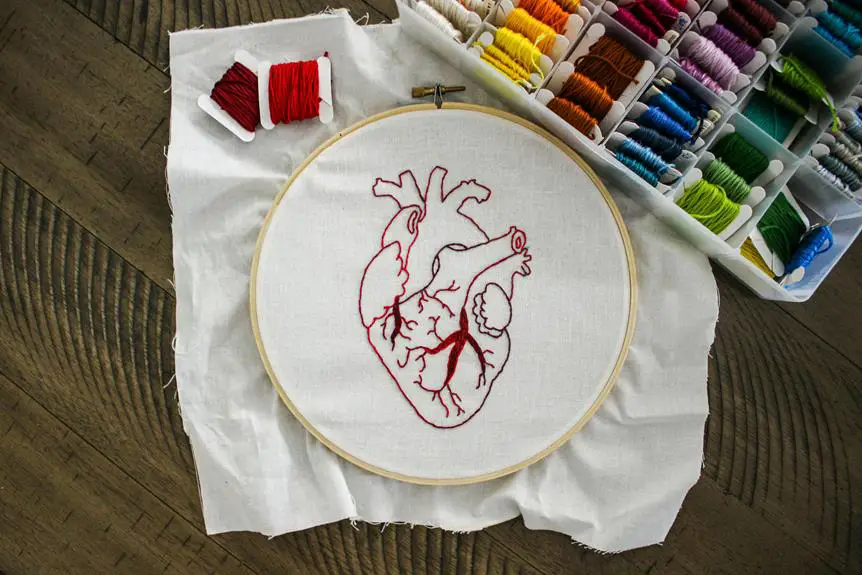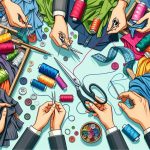When you consider fabric crafts, you might not immediately think of bleaching as a beneficial technique, but it offers unique opportunities for design and creativity. By experimenting with bleach, you can transform ordinary fabrics into stunning pieces that reflect your personal style. This method not only enhances colors but also allows for intricate patterns that can elevate your projects. Plus, there's the added benefit of upcycling old textiles, promoting sustainability in your craft. So, what are the specific techniques you can explore to achieve these remarkable effects?
Table of Contents
Key Takeaways
- Bleaching fabric allows for the creation of unique artistic designs, enhancing creativity with striking contrasts and intricate patterns.
- Upcycling old fabrics through bleaching is cost-effective, transforming worn items into stylish, custom pieces while promoting sustainability.
- Ombre and tie-dye techniques using bleach yield one-of-a-kind designs, showcasing individuality and the potential for experimentation in fabric crafts.
- Bleached fabrics can be easily restored with vibrant colors using specialized dyes, adding depth and richness to projects.
Unique Design Possibilities
Fabric bleaching opens up a world of unique design possibilities, allowing you to transform ordinary textiles into stunning pieces of art. You can create striking contrasts and intricate patterns that set your projects apart. By strategically applying bleach, you'll achieve stunning effects, like tie-dye or ombre, which can elevate even the simplest fabric.
Experimenting with different techniques can further enhance your creative process. Try splattering bleach for a fun, random effect or use stencils to create defined shapes and designs. You might also consider using different concentrations of bleach to produce various shades and tones, adding depth to your textile art.
Don't forget about fabric manipulation! You can scrunch, fold, or twist your fabric before applying bleach to create unique textures and patterns that surprise you. Once you see how bleach interacts with different fabrics, you'll discover endless opportunities to express your creativity.
Color Enhancement Techniques
How can you enhance the colors of your bleached fabrics to make them truly pop? With a few simple techniques, you can elevate your projects and create stunning visual effects. Start by using fabric dyes or paints specifically designed for use on bleached materials. These products can bring back vibrant colors and create unique patterns.
To further enhance your bleached fabrics, consider the following tips:
- Layering: Apply multiple colors in layers to achieve a rich, dimensional look.
- Spray Bottles: Use spray bottles filled with diluted dye for a watercolor effect, allowing colors to blend seamlessly.
- Resist Techniques: Use wax or rubber bands to create resist patterns, ensuring some areas remain untouched by dye.
- Stencils: Incorporate stencils for precise designs and sharp color contrasts.
Stain Removal Solutions
Finding the right stain removal solution can make all the difference in preserving your bleached fabrics. When dealing with stains, acting quickly is key. You'll want to assess the stain type first. For organic stains like food or dirt, a mixture of water and mild detergent usually does the trick.
If you're facing tougher stains, consider using a stain remover specifically designed for delicate fabrics. Always test the solution on a hidden area to ensure it doesn't affect the bleach or fabric quality.
For ink stains, rubbing alcohol can be effective. Dab it onto the stain with a cotton ball, and then rinse thoroughly. Be careful not to rub too hard, as this could damage your fabric.
Oily stains may require a bit more effort. Sprinkle cornstarch or baby powder on the stain to absorb the oil, let it sit for a few hours, and then brush it off before washing.
Upcycling Old Fabrics
Upcycling old fabrics is a fantastic way to breathe new life into your craft projects.
You can transform worn materials into creative masterpieces while saving money and reducing waste.
Let's explore how these cost-effective transformations can spark your imagination.
Creative Fabric Transformations
Transforming old fabrics into something new and beautiful not only breathes life into forgotten materials but also sparks your creativity.
With a little imagination and some bleaching techniques, you can completely reinvent fabrics that may have lost their charm. Here are some fun ideas to get you started on your creative journey:
- Tote Bags: Repurpose old fabric into stylish tote bags. Bleach patterns can add a unique touch.
- Cushion Covers: Transform worn-out linens or clothes into eye-catching cushion covers with your own designs.
- Wall Art: Use bleached fabric scraps to create beautiful wall hangings or framed art pieces.
- Fashion Accessories: Turn old shirts into trendy scarves or headbands with clever bleaching techniques.
Cost-Effective Material Renewal
Reviving your old fabrics not only saves money but also adds a personal touch to your projects. Using bleach can help you transform worn-out materials into beautiful, unique pieces that reflect your style. Upcycling is a fantastic way to reduce waste and express your creativity.
Here's a quick comparison of what you can achieve with bleaching versus buying new fabrics:
| Action | Cost | Outcome |
|---|---|---|
| Bleaching Old Fabric | Low (minimal bleach) | Custom, one-of-a-kind pieces |
| Buying New Fabric | High (varies) | Generic, mass-produced items |
| Upcycling | Minimal (time and effort) | Personal, environmentally-friendly creations |
Ombre and Tie-Dye Effects
Creating stunning ombre and tie-dye effects with fabric bleaching can add a unique flair to your craft projects. You can transform plain fabrics into eye-catching pieces that reflect your personal style. With just a few supplies and some creativity, you can achieve beautiful results.
To get started, gather these essential items:
- Fabric: Choose natural fibers like cotton for the best results.
- Bleach: Use a diluted bleach solution for control over the fading process.
- Rubber bands or string: These help create patterns and prevent bleach from spreading evenly.
- Spray bottle: This allows for easy application of bleach in desired areas.
Once you have your supplies, experiment with different techniques. For ombre, gradually spray or dip the fabric in bleach, working from dark to light.
For tie-dye, twist and bind the fabric before applying bleach, and watch as unique patterns emerge. Each project will be one-of-a-kind, showcasing your creativity. Enjoy the process, and let your imagination run wild!
Safety Tips for Bleaching
When working with bleach, it's crucial to prioritize your safety by wearing protective gear and ensuring proper ventilation in your workspace. Start by putting on gloves to protect your hands from irritation, and consider wearing a mask to avoid inhaling fumes. Safety goggles are also a smart choice to shield your eyes from splashes.
Next, choose a well-ventilated area for your project. Open windows and use fans to circulate air, reducing the concentration of fumes. If possible, work outdoors to further minimize exposure.
Always keep a bottle of water or a neutralizing agent like vinegar nearby in case of spills or skin contact. If you accidentally get bleach on your skin, rinse the area immediately with plenty of water.
Be mindful of the surfaces you're working on. Use a drop cloth to protect your workspace and avoid unwanted bleaching of surrounding areas.
Lastly, never mix bleach with other cleaning products, especially ammonia, as this can create hazardous gases. By following these safety tips, you can enjoy your fabric bleaching projects with peace of mind.
Frequently Asked Questions
Can I Bleach Synthetic Fabrics Safely?
You can bleach synthetic fabrics, but it's risky. Many synthetic materials can weaken or discolor. Always check the care label, test a small area first, and consider alternative methods to achieve your desired results safely.
How Does Bleach Affect Fabric Texture Over Time?
Bleach can gradually weaken fabric fibers, leading to a rougher texture over time. You might notice increased brittleness, especially with frequent use, so it's essential to balance bleaching with proper care to maintain fabric quality.
What Is the Best Bleach Concentration for Fabric Crafts?
For fabric crafts, a bleach concentration of 5-10% is best. It effectively removes color without damaging fibers. Always test on a small area first, and remember to dilute it properly for safe use.
Can I Mix Bleach With Other Chemicals in Fabric Projects?
You shouldn't mix bleach with other chemicals. Combining bleach with substances like ammonia can create toxic fumes that are harmful. Stick to using bleach alone for safety and effectiveness in your fabric projects.
How Should I Store Bleached Fabrics After Crafting?
After crafting, store bleached fabrics in a cool, dry place away from direct sunlight. Use breathable containers, like cotton bags or bins, to prevent moisture buildup, which can cause yellowing or mildew over time.
- Does Chiffon Fabric Stink - July 15, 2025
- Does Chiffon Fabric Affect the Economy - July 15, 2025
- Does Cotton Fabric Have a Nap - July 15, 2025







